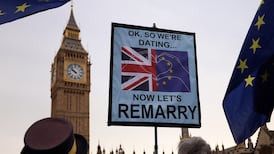The most welcome aspect of the Government's White Paper Ireland's Transition to a Low Carbon Energy Future 2015-2030 is that it sets any targets at all, given that its climate change legislation failed to set specific objectives for any sector of the economy to reduce their greenhouse gas emissions.
Now, at least we know that the target for energy is to slash carbon emissions by up to 95 per cent between now and 2050 and to achieve full de-carbonisation of the sector by 2100 – admittedly, long after most people alive today will have passed on.
In his "message" for the 126-page White Paper, Taoiseach Enda Kenny says it "confirms our core objectives of sustainability, security of supply and competitiveness", striking a balance between them to achieve a low-carbon future and seeking to "empower and engage communities across Ireland" in a debate about the energy challenges we face.
As Minister for Energy Alex White notes in his introduction, technologies such as smart meters, heat pumps and "mobile connectivity" would allow citizens to "boost energy efficiency and save money by managing their energy use".
One of the White Paper’s declared aims is to “accelerate the development and diversification of renewable energy generation”.
But it is clear that onshore wind farms “will continue to make a significant contribution”, as the Minister writes, given that offshore wind is significantly less cost-effective while technologies to harness wave and tidal power are still embryonic.
Solar energy is much more competitive, but one wonders how effective it would be in Ireland given that we enjoy 1,100 to 1,600 hours of sunshine per year, compared to between 2,700 and 3,000 hours per year in Spain, for example.
Onshore wind farms have become more controversial due largely to the scale of contemporary turbines in the rural landscape and their proximity to people’s homes with the current minimum “separation distance” of 500 metres.
Revised planning guidelines for wind energy development were promised in 2013, but have not yet been published – and they are now unlikely to see the light of day this side of the forthcoming general election, unless the new standards can be sold as “good news” for rural Ireland.
Following adoption of the Paris Agreement on climate change, all political parties need to commit to a “whole of government” approach to reducing Ireland’s emissions, rather than merely making a special case in Brussels for continued expansion of the agricultural sector, which accounts for a third of the total.
Setting a realistic price for carbon, as French President François Hollande proposed in Paris, especially with oil now trading at less than $40 per barrel – the lowest in seven years – would do more than anything to speed the transition to a low-carbon future which is essential to save the planet.








